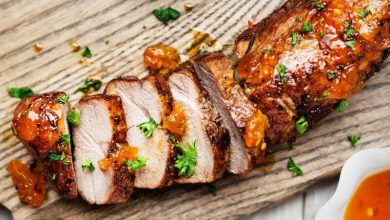🍗🥢 Asian-Style Chicken: A Flavorful Delight 🥡🌟
Asian-style chicken is a delectable culinary creation that spans a diverse range of recipes across various Asian cuisines. Whether you’re savoring a bowl of General Tso’s Chicken, sizzling Orange Chicken, or the classic Teriyaki Chicken, each dish carries its unique history, components, and preparation techniques.
📜 History:
The history of Asian-style chicken is deeply rooted in the rich culinary traditions of Asia. These dishes are the result of centuries of culinary evolution, influenced by a variety of cultures and flavors. For example, General Tso’s Chicken is believed to have originated in Taiwan but is now a popular American Chinese dish. Teriyaki Chicken, on the other hand, has Japanese origins. Over time, these dishes have been adapted to local tastes and ingredients, creating a tapestry of Asian-inspired chicken dishes enjoyed worldwide.
🥘 Components:
The components of Asian-style chicken dishes can vary, but they generally include the following elements:
- Chicken: Typically, boneless, skinless chicken pieces are used. You can choose from chicken breast, thighs, or wings, depending on your preference.
- Sauce: The sauce is the heart of these dishes. It could be sweet, savory, spicy, or a combination of these flavors. Soy sauce, hoisin sauce, oyster sauce, and ginger are common components.
- Vegetables: Many recipes include vegetables like bell peppers, broccoli, or snap peas for added color, texture, and nutrition.
- Aromatics: Ingredients like garlic, ginger, and scallions are used to infuse the dish with distinctive flavors.
🍴 Steps to Prepare:
The preparation of Asian-style chicken involves several steps, and the specifics can vary depending on the recipe. Here’s a general outline of how to prepare it:
-
Cut and Marinate the Chicken: Start by cutting the chicken into bite-sized pieces. Marinate it with soy sauce, ginger, garlic, and sometimes cornstarch to tenderize the meat.
-
Prepare the Sauce: In a separate bowl, mix the sauce ingredients, which may include soy sauce, hoisin sauce, sugar, vinegar, and red pepper flakes for heat.
-
Stir-Fry: Heat a wok or a large skillet and add oil. Stir-fry the marinated chicken until it’s cooked through and has a nice sear. Remove the chicken from the pan.
-
Sauté Vegetables: In the same pan, add more oil and stir-fry the vegetables until they’re crisp-tender.
-
Combine and Simmer: Return the cooked chicken to the pan and pour the sauce over it. Stir to coat the chicken and vegetables with the sauce. Simmer until the sauce thickens.
-
Serve: Serve your Asian-style chicken over steamed rice or noodles. Garnish with sesame seeds, chopped scallions, or sesame oil for extra flavor.
⏰ Preparation Time:
The time needed to prepare Asian-style chicken can vary depending on your cooking skills and the recipe’s complexity. On average, it might take approximately 30-45 minutes from start to finish, making it a convenient option for a delicious weeknight dinner.
🥡 Enjoy the rich, flavorful world of Asian-style chicken dishes! Each bite is a fusion of history and culinary delight. 🌏🍽️
🥗📊 Nutrition Facts and Health Information for Asian-Style Chicken 🍗🌱
Asian-style chicken dishes can be both delicious and nutritious, provided you choose the right ingredients and cooking methods. Here’s a general overview of the nutrition and health considerations for these dishes:
📈 Nutrition Facts (per serving, approximately 1 cup of cooked chicken with vegetables and sauce):
- Calories: Around 300-400 calories, but this can vary depending on the recipe and serving size.
- Protein: A typical serving provides 20-30 grams of protein, making it a good source of this macronutrient.
- Carbohydrates: Approximately 20-40 grams of carbohydrates, mainly from the sauce and any rice or noodles served with it.
- Fat: Around 10-20 grams of fat, which includes healthy fats from ingredients like sesame oil or nuts.
- Fiber: Limited fiber content unless you add more vegetables to the dish.
🍽️ Health Information:
-
Protein Source: Chicken is a lean source of protein, which is essential for muscle growth and repair. It also helps you feel full and satisfied.
-
Sauces: Be mindful of the sauce used in your Asian-style chicken. Many commercial sauces can be high in sodium, sugar, and artificial additives. Consider using reduced-sodium soy sauce or making your own sauce to control the ingredients.
-
Vegetables: These dishes often contain a variety of vegetables, which provide essential vitamins, minerals, and fiber. The more veggies, the better for your health!
-
Cooking Method: Stir-frying, a common method for preparing Asian-style chicken, requires only a small amount of oil. This can be a healthier option compared to deep-frying. You can also choose healthier oils like olive or avocado oil.
-
Balanced Meal: For a balanced meal, serve your Asian-style chicken with brown rice or whole-grain noodles. These complex carbohydrates add fiber and provide sustained energy.
-
Portion Control: Be cautious with portion sizes, as the calorie content can add up quickly. Using a smaller plate can help you control your serving size.
-
Customization: You can customize these dishes to suit your dietary preferences. For a healthier twist, consider using tofu or tempeh as a protein source or using low-sodium and low-sugar sauce options.
-
Allergens: Be aware of allergens. Some Asian-style chicken dishes may contain ingredients like peanuts or tree nuts, which can trigger allergies in some individuals.
Remember, the overall healthiness of your Asian-style chicken dish depends on the specific recipe and how it’s prepared. By making mindful ingredient choices and controlling portion sizes, you can enjoy a tasty meal that fits into a balanced diet. 🥢🥦🍚




